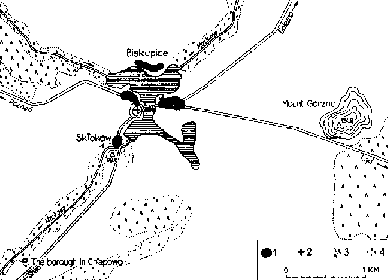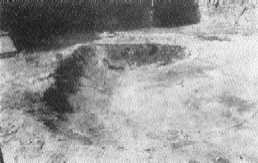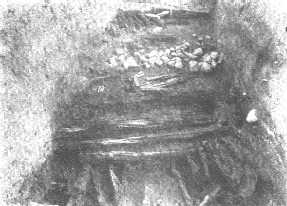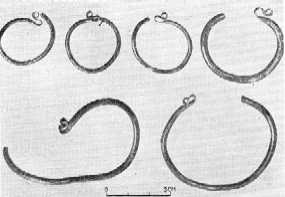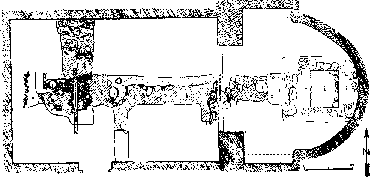
Bogdan Kostrzewski
The Duke's Borough in Giecz, Środa District
When studying the beginnings of the Polish State, Giecz, Środa District is not to be overlooked. Although the place may not have played any important role in the forming of Poland's first outlines, its meaning grew significantly in the early Piast period. This is proved by a reference in Gall Anonims' chronicle, who, w hen describing the armed forces of Bolesław Chrobry (the Brave) mentions Giecz as equal to Poznań, Gniezno and Włocławek. In another written source, namely the Czech chronicle of Kosmas, we find a description of taking possession of Giecz by the Prince Brzetysław in his armed expedition to Poland in 1039.
Both sources mentioned above indicate the military meaning of the borough Giecz and its defensive character in relation to Gniezno. There is no doubt, however, that in the 11th century, may be already during the reign of Bolesław the Brave, Giecz was a castellan's seat, although written sources mention castellans of Giecz not earlier than in the 13th century. Thus the borough with its surrounding suburbia and neighbouring settlement, subjected to its administrative and economic rules, was nonetheless potentially a strong complex, able to form an urban centre in favourable conditions. We do not possess convincing proofs, confirming that the development of Giecz had reached the mentioned level, and no reference shows that the town was endowed with German Law, some indications, however, allow to believe that already in the 11th century a market settlement was open here. Its beginnings may have fitted into the defensive suburbium, developing further into an open settlement, lying close to the Romanesque church of Giecz, on the east bank of the Moskawa River.
It is very probable that Giecz was the hereditary property of Poland's first rulers. This may be proved by the strength of fortifications, the borough's large surface and a dense settlement grouping all round it. Only the important chieftain's boroughs in Great Poland, i.e. Kruszwica, Gniezno and Poznań are characteristic for similar features.
The favourable geographical situation of Giecz had in a certain measure been helpful to the role and meaning played by Giecz in the Poland of early Piast times. The borough was built upon a peninsula of the lake not existing today, which in connection with Moskawa's swampy valley and a stream falling into the lake from its north-west (fig. 1), formed an excellent line of defense from north and east. It was a crossing point of two important roads, one of which led from Silesia through Śrem to Gniezno, and the other from Mazowia through Ląd to Poznań. The Duke Brzetysław undoubtedly led his army from Czechoslovakia to Gniezno by the first of the two mentioned ways. Both tracks formed the economical development of Gniezno and changes occurring in their direction in the 13th century no doubt brought about the later fall of this settlement complex.
(According to B. Jarnot drawn by F. Neja)
Giecz had been since long ago a source of interest for historians and archaeologists. Regular excavation investigations have been started here, however, only in 1949 under the management of the author of this article, first in the framework of research concerning the beginnings of the Polish State, later by the Institute of History of Material Culture of the Polish Academy of Sciences. Research was systematically con ducted, interrupted only in the years 1954, 1956 and 1957 by the necessity of elaborating all archaeological material acquired. Excavation works were started in the south-east part of the borough, where already in 1949 a stone foundation laid under the 11th century palace was found, then the open settlement lying to the south-east of the borough, the open suburbia situated north-west from the borough, the dike and bridge linking the borough with the settlement Giecz, the Romanesque church and its surroundings have been successively investigated.
Applying research to the mentioned foundation was indeed difficult on account of a cemetery opened here somewhere about the half of the 19th century and partially used still in 1957 (fig. 2). Only after the establishing of a new cemetery in 1959 by the parish and transferring all graves to it, a regular research in this spot was possible. The foundation is built of big rough stones linked with clay and levelled with smaller stones. The foundation's digging is only 60 cm. deep. Older culture layers cut through by that digging and culture relics lying direct upon the foundation, also some coins called bishop's denars, have allowed to determine the building of t his edifice to the first half of the 11th century. No other than Bolesław the Brave or Mieszko II must have been its foundationer.
The horizontal plan of the whole building complex (fig. 3) is composed of two parts i.e. the palatium having the shape of an elonged rectangle and the rotund palace chapel touching its east gable and. Both parts must have been raised at the same time according to one architectural plan which may be proved by the uniform character of the whole of the edifice and a lack of traces of joining different parts. The total length of the complex of buildings along the east-west axle is 47 m., the palatium itself measures 35 m. in length. Its width is 16 m. repeated also in the rotunda's diameter. The palatium's inside has 5 spaces of unequal dimensions. Maybe that those lying close to the chapel were designed to serve religious aims. Although we are not well informed what was the function of similar rooms, we must admit that such a palatium complex is no exception in Poland's early mediaeval stone architecture. A similar method of joining the building meant for cult with the palatium, an identical horizontal plan of the edifice and analogous dimensions are characteristic to a similar object upon Ostrów Lednicki, only 25 km. distant from Giecz. As we are certain that the palatium of Ostrów Lednicki was built earlier, during the reign of Mieszko I, it is easy to guess that it was a model for the builders of the Giecz palace. They did not, however, succeed to finish their work. Disturbances during the reign and after the death of Mieszko II, moreover, the Czech invasion in 1039 put a stop to the continuation of building upon the level of the foundation's top. Our supposition is supported by the entire lack of traces of ruins and lime mortar which should lie about if the standing edifice had to be pulled down to its foundations.
The palatium complex in Giecz, although unfinished, offers a valuable document to our knowledge of the proto-Romanesque architecture. It also stresses the meaning of the Giecz borough in Piast Poland. The discovery of a palatium and rotunda is also the most important acquisition of our archaeological research in Giecz.
The successors of Mieszko II did not continue the interrupted building. The enterprise may have exceeded their means, or maybe Giecz had already lost the meaning it used to have in the time of their predecessors. The centre of power was soon after transferred to the borough's north part and suburbia appear all over the covered foundations. Thus have the suburbia persisted till now, injured only by some of the deeper grave pits. Investigation of the western win g of the palatium complex, revealed three successive settlement layers over the foundation, kept better than in other diggings of this part of the borough. In these layers coming probably from the half of the 11th up to the 13th century, each of which bears traces of fire, have been found remains of houses normal or half-built into the earth, with wooden walls of an angle construction and beaten clay floors. In one of them we find the lower parts of wooden walls, fallen over the clay floor during the fire (fig. 4). In the close vicinity of another house was hidden a baking oven mad e of stones linked with clay (fig. 5), much damaged by grave digging. Among the relics speaking of the inhabitants jobs we may mention: corn grains, farming tools, (fig. 6), two arms of scales used for weighing silver, a silver coin of the 11th century, craft implements and manufactured objects. In the neighbouring dug-outs remainders of iron furnaces and iron slag have been found. All this material would prove that the suburbium's inhabitants' chief occupations were: farming, smelting, handicraft and trade. The mentioned suburbium was separated from the borough by an inner rampart, hardly visible today but for a sort of long eminence running across the borough's axle. Its examination revealed that the rampart was laid upon a wooden chest-type construction, well filled with compact loam where the wood was conserved only in the form of thin streaks. The rampart was respected only up to the 13th century, then it was levelled to make possible the building of houses with beaten clay floors and stone hearths.
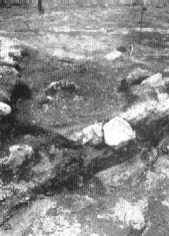
|

|
|
Fig. 5. Foundation and part of the baking ovens's hearth. (Phot. Z. Ratajczak) |
Fig. 6. Iron hoe. (Phot. C. Czub) |
A close examination of the outer rampart, being still some 8 m. high would involve very great expenses, therefore only the investigation of its higher part telling the end of its defensive role, was decided. A digging drawn through the south part of the rampart near the gate has shown that its highest layer strengthened with wooden grates had been destroyed by fire probably in the 12th century, at any rate after Brzetysław's assault. It may also be that the fire broke out in the first half of the 13th century, during inland struggles of the princes Henryk Brodaty and Władysław Odonicz in the course of which Giecz had been conquered. The rampart was not repaired after this disaster till in the 14th century, it was finished along the top by a compact cover of sand. This is the last time that the fortifications of Giecz were to be cared for. Their earlier history is impossible to be read from what the excavation disclosed. Another excavation drawn in 1960 through the north-east part of the borough, in the place where the rampart had been levelled in the beginning of the 20th century has not been more successful till today. It has, however, disclosed foundations of two other ramparts. One of them massively built was supplied from the outside with a stone bench upon which another rampart built of thin be am s was superlaid. Both had a wooden grate construction (fig. 7).
(Phot. C. Czub)
Three of the surrounding settlements indicate a definite dependance from the borough. One of the most closely examined, lying several hundred meters to the south of the borough, may be considered as the settlement confirmed by a document of 1240 appearing near the ford Skłoków. Besides traces of older settlements, among others a cemetery of the Pomeranian culture and several bell graves, some semi-subterranian houses with stone hearths and a meagre early mediaeval inventory have been found. This settlement's beginnings seems to belong to the 9th century i.e. the oldest phase of the Giecz borough whose full development falls not earlier than the 10th and 11th centuries. It existed probably, however, also later which is proved by fragments of bricks and late mediaeval and newer pottery. This would agree with source information mentioning here a village in the 18th century. The early mediaeval cottages, their character and inventory allow to presume inhabitants of a poor population living of farming, fishing, perhaps also smelting and being servants to the borough. In connection with this settlement we shall mention a puzzling detail which are two unusual stone pavements, discovered in its close vicinity on the lake's south coast. The pavements were superlaid one over the other, the older one made of larger stones and determined by pottery to the late La Tène period, was separated from the later and more dense one by a barren layer of peated earth and a thin culture layer containing hand-made early mediaeval pottery. It is interesting to mention that the pavements appeared not only on the softly declining coast, but also in the bot tom of the lake, not existing today. We are not able to determine their function whatever it might be.
The second of the three mentioned settlements, lying nearest to the borough, separated from it only by a narrow bay of the lake, requires closer investigation. Only a very small part of it, which would be the settlement's north-east border, has been s o fair disclosed. A number of pits determined to the 11th century by pottery, have here been found. Fragments of a badly kept earth construction which might be the remainders of a destroyed rampart or any other fortification have recently been discovered. A valuable result of investigations carried out in this part of the suburbium, was the finding of 26 skeleton burials, only two of which were found untouched. The rest had been destroyed by soil cultivation or digging activity. Some of them might be secondary burials, confirmed, by the witness of the local population who speaks of discovering graves of „knights”. It is not excluded that a fine iron helmet covered with gilded cooper, found in Giecz before 1914 and having no exact localization may have been drawn from one of these graves. The layers of earth covering the burials and also their very level have revealed a number of relics: ceramics, knives, iron cross-bows arrows, whetstones, spinning whorls, and 6 bronze temple-pendants (fig. 8) two of them silver-plated. Part of these might have been equipments of the devastated graves. These relics are supposed to date from the 11th and 12th centuries.
Burials whose chronology is difficult to determine, probably early and late mediaeval ones, much destroyed by all kinds of digging and often being secondary graves, have also been discovered in the suburbium close to St. John the Baptist's church and in Giecz itself near the Romanesque church of St. Nicholas. These burials are remainders of cemeteries which used to be placed round churches, during all the centuries from Middle Ages up to Modern Times. Investigations carried out in the settlement Giecz and grouped mostly round its central spot i.e. the Romanesque church mentioned above (fig. 9), have not supplied till now satisfactory results, on account of the culture layers being almost totally destroyed by grave digging. Only in a digging, placed about 100 m. south from the church, the remainders of a lime-pit have been found. According to fragments of ceramics scattered there, the pit may be dated to the 12th century, which would agree with the time of raising of the Romanesque church.
Research applied to the inside of the church (fig. 10) and conducted simultaneously to conservation work, has been more fruitful. A floor belonging to an older church has been discovered at the depth of ca. 120 cm., it is composed of big rough stones lying direct upon virgin soil. The dimension of the floor, somewhat damaged by grave digging were nearly identical with the outlines of the later church, its foundations resting upon the remainders of the old wall, which is proved by findings in the lateral north digging. Short of certain criteria, we are unfortunately not able to determine the chronology of the older temple. We may only suppose that its raising occurred in the end of the 10th or the beginning of the 11th century. The examination of the floor has allowed to discover the foundations of two pillars built with a layer of flat Romanesque blocks and conserved up to the height of 1 m., in the middle of the nave under the bow-arc and near the west wall. These pillars belonged probably to the later church, their function is, however, not very clear. Thanks to restoration works applied to the church, there has been discovered a Romanesque mensa, which after removing of later changes and deformations, represents a big stone cube built of 7 layers of stone blocks.
All the three settlements mentioned above were connected with each other by roads, being parts of the far-reaching tracks leading through Giecz. One of them, connecting the borough with the Giecz settlement ran right through the bot tom of the former lake, which is proved by traces of a strong dike, 16 m. wide. The dike stood upon several rows of stakes, parallel to its direction, the space between being filled up with be am s alternately disposed (fig. 11). The top was strengthened with earth and stones. Various relics found in wooden constructions account for the dating of the dike to the 11th or 12th century. It must of course have been used also at a later period. The borough had a second way of communication with the lake's other coast and this was a bridge, running nearly parallel to the dike at a distance of ca. 100 m. As the bridge measures also 6 m. in width, we may assume that it served more than local traffic. We have not yet succeeded to determine the time of building of the bridge. It seems to be older than the dike and was probably not used at the same time.
Excavation works in Giecz have not yet determined a number of problems that are of lively interest to us. That is why they will certainly be continued in the nearest future. However, we may already say that the results of our research are a valuable archaeological material to the knowledge of more than Giecz itself. Research applied to the Giecz settlement complex will lead to a better knowledge concerning the forming of early mediaeval urban centres and the role of trade routes. The discovery of the palatium and rotunda will also greatly add to our knowledge of proto-Romanesque architecture in Poland.

|

|
Rezerwat Archeologiczny – Gród Piastowski w Gieczu Grodziszczko 2, 63–012 Dominowo |
|
